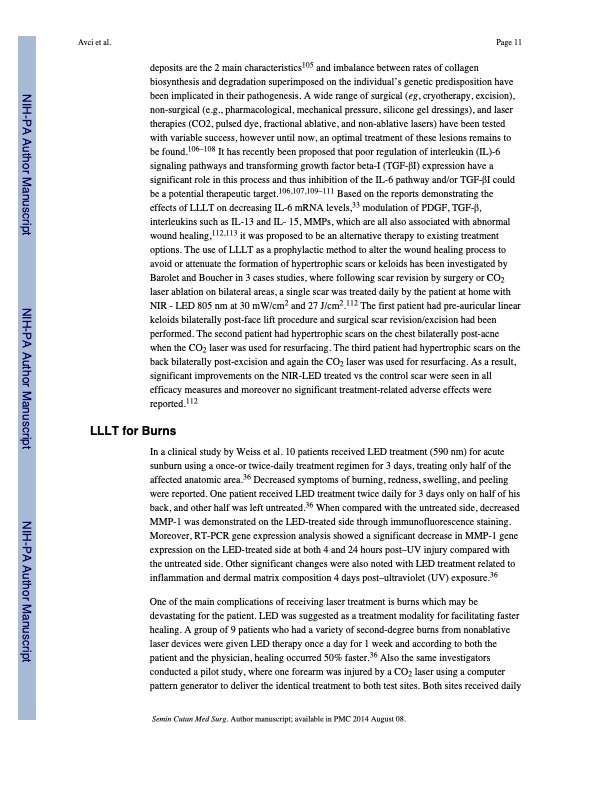
PDF Publication Title:
Text from PDF Page: 011
Avci et al. Page 11 deposits are the 2 main characteristics105 and imbalance between rates of collagen biosynthesis and degradation superimposed on the individual’s genetic predisposition have been implicated in their pathogenesis. A wide range of surgical (eg, cryotherapy, excision), non-surgical (e.g., pharmacological, mechanical pressure, silicone gel dressings), and laser therapies (CO2, pulsed dye, fractional ablative, and non-ablative lasers) have been tested with variable success, however until now, an optimal treatment of these lesions remains to be found.106–108 It has recently been proposed that poor regulation of interleukin (IL)-6 signaling pathways and transforming growth factor beta-I (TGF-βI) expression have a significant role in this process and thus inhibition of the IL-6 pathway and/or TGF-βI could be a potential therapeutic target.106,107,109–111 Based on the reports demonstrating the effects of LLLT on decreasing IL-6 mRNA levels,33 modulation of PDGF, TGF-β, interleukins such as IL-13 and IL- 15, MMPs, which are all also associated with abnormal wound healing,112,113 it was proposed to be an alternative therapy to existing treatment options. The use of LLLT as a prophylactic method to alter the wound healing process to avoid or attenuate the formation of hypertrophic scars or keloids has been investigated by Barolet and Boucher in 3 cases studies, where following scar revision by surgery or CO2 laser ablation on bilateral areas, a single scar was treated daily by the patient at home with NIR - LED 805 nm at 30 mW/cm2 and 27 J/cm2.112 The first patient had pre-auricular linear keloids bilaterally post-face lift procedure and surgical scar revision/excision had been performed. The second patient had hypertrophic scars on the chest bilaterally post-acne when the CO2 laser was used for resurfacing. The third patient had hypertrophic scars on the back bilaterally post-excision and again the CO2 laser was used for resurfacing. As a result, significant improvements on the NIR-LED treated vs the control scar were seen in all efficacy measures and moreover no significant treatment-related adverse effects were reported.112 LLLT for Burns In a clinical study by Weiss et al. 10 patients received LED treatment (590 nm) for acute sunburn using a once-or twice-daily treatment regimen for 3 days, treating only half of the affected anatomic area.36 Decreased symptoms of burning, redness, swelling, and peeling were reported. One patient received LED treatment twice daily for 3 days only on half of his back, and other half was left untreated.36 When compared with the untreated side, decreased MMP-1 was demonstrated on the LED-treated side through immunofluorescence staining. Moreover, RT-PCR gene expression analysis showed a significant decrease in MMP-1 gene expression on the LED-treated side at both 4 and 24 hours post–UV injury compared with the untreated side. Other significant changes were also noted with LED treatment related to inflammation and dermal matrix composition 4 days post–ultraviolet (UV) exposure.36 One of the main complications of receiving laser treatment is burns which may be devastating for the patient. LED was suggested as a treatment modality for facilitating faster healing. A group of 9 patients who had a variety of second-degree burns from nonablative laser devices were given LED therapy once a day for 1 week and according to both the patient and the physician, healing occurred 50% faster.36 Also the same investigators conducted a pilot study, where one forearm was injured by a CO2 laser using a computer pattern generator to deliver the identical treatment to both test sites. Both sites received daily Semin Cutan Med Surg. Author manuscript; available in PMC 2014 August 08. NIH-PA Author Manuscript NIH-PA Author Manuscript NIH-PA Author ManuscriptPDF Image | Low-level laser (light) therapy (LLLT) in skin: stimulating, healing, restoring

PDF Search Title:
Low-level laser (light) therapy (LLLT) in skin: stimulating, healing, restoringOriginal File Name Searched:
nihms430657.pdfDIY PDF Search: Google It | Yahoo | Bing
Cruise Ship Reviews | Luxury Resort | Jet | Yacht | and Travel Tech More Info
Cruising Review Topics and Articles More Info
Software based on Filemaker for the travel industry More Info
The Burgenstock Resort: Reviews on CruisingReview website... More Info
Resort Reviews: World Class resorts... More Info
The Riffelalp Resort: Reviews on CruisingReview website... More Info
| CONTACT TEL: 608-238-6001 Email: greg@cruisingreview.com | RSS | AMP |